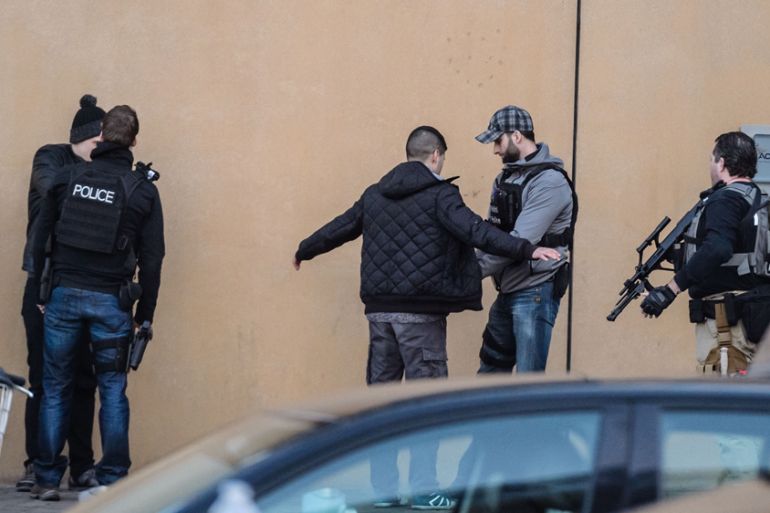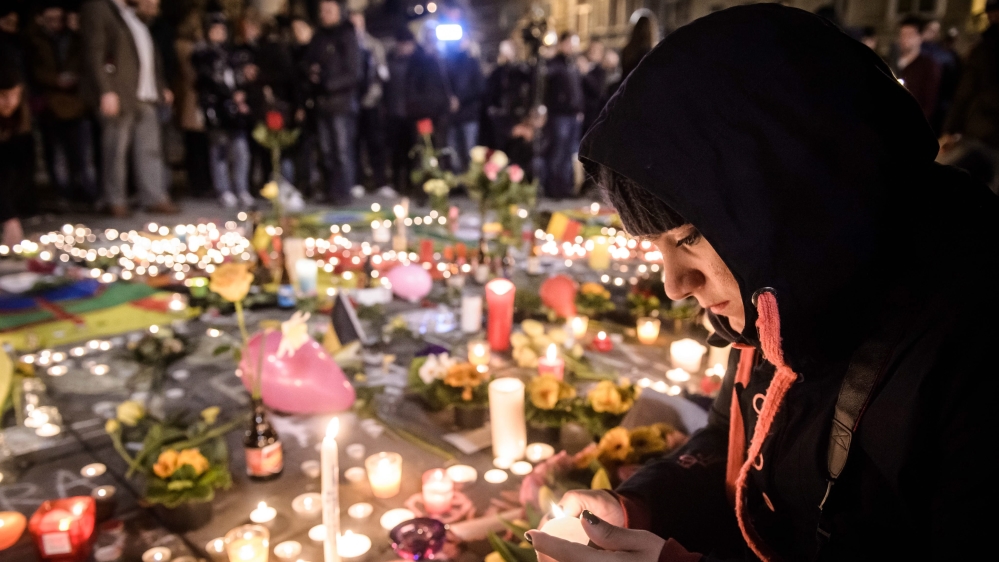Brussels attack suspects named as manhunt intensifies
Police comb Belgian capital for third suspect as prosecutor says two bombers were brothers involved in organised crime.

A massive manhunt is under way for a suspect seen with two supposed suicide bombers shortly before they struck Brussels’ airport in the first of two attacks that also hit the city’s metro, killing 31 people and wounding 261.
![A CCTV image from the Brussels Airport shows the suspects of the Brussels airport attack [Reuters]](/wp-content/uploads/2016/03/8d532692f1f84cf3a92f84fb2697d3c0_18.jpeg)
Brahim, pictured in the middle of a surveillance photo at the airport, had been identified using fingerprint records, Van Leeuw said.
Keep reading
list of 4 itemsUS sanctions two RSF commanders as fighting escalates in Sudan’s Darfur
Mozambique’s president says northern town ‘under attack’ by armed groups
What’s next as ‘heavy-handed’ US negotiates pullout from Niger?
The second airport suicide bomber, on the left of the picture, has not been identified. The third suspect, who left the airport before the explosions, is also not yet identified and remained on the run, Van Leeuw said.
The prosecutor also confirmed that police had carried out raids following Tuesday morning’s attacks, including at an address associated with the suspects after a tip-off by a taxi driver who drove the attackers to the airport.
During a house search in the Brussels neighbourhood of Schaerbeek, investigators found 15 kilos of explosives, detonators and chemical products, Van Leeuw said.
Police also found a computer in a rubbish container in the street that included a note by Brahim, the airport bomber, in which he said he felt increasingly unsafe and feared landing in prison.
“Always on the run, not knowing what to do any more, being looked for everywhere, not being safe any longer,” the prosecutor quoted Brahim’s note as saying.
Van Leeuw said that one person arrested in one of the raids remained in custody on Wednesday and is being questioned.
The prosecutor spoke shortly after crowds of mourners gathered outside Maelbeek station, one of the targets of the attacks, to observe a minute of silence.
The Islamic State of Iraq and the Levant (ISIL, also known as ISIS) claimed responsibility for the attacks.
“This is a day of tragedy, a black day,” Belgian Prime Minister Charles Michel said, describing the bombings as the “deadliest attacks we have ever seen in Belgium”.
But as Belgium began three days of national mourning on Wednesday, he insisted that the country would not be cowed by the “blind, violent and cowardly” attacks.
 |
| People gather and light candles at the Place de la Bourse during a vigil to pay tribute to the victims of the attacks [EPA] |
Belgian authorities released pictures of two of the suspects pushing trolleys with their bombs through the terminal and said that they were “actively searching” for a third man whose explosives did not go off.
Police helicopters hovered over the city late into the night on Tuesday and raids were carried out across Belgium, prosecutors said, adding that a bomb, an ISIL flag and chemicals had been found in one apartment.
Police were going door-to-door throughout Brussels searching for suspects or others planning attacks. The interior minister said 600 additional police were deployed.
#BrusselsAttacks: Grief, Islam and double standards
Al Jazeera’s Dominic Kane, reporting from Brussels, said many in the country were asking whether the attacks represented a continuing threat.
|
|
“Belgians feel this is something they’ll now have to get used to … the editor of a prominent Belgian news outlet wrote that she believed this was something that was becoming part of the system.
“[She said] this was something people have to get used to and have to explain to their children that there is a threat and life has changed.”
Kane said that there was also a sense that the blasts were a calculated attack on European institutions and the “fabric of Europe”.
On social media, thousands of people shared images of beloved Belgian cartoon character Tintin in tears.
The explosions struck at the heart of European officialdom where NATO headquarters is based, along with the European Union, and European Commission.
OPINION: EU’s terror problem will get worse
Witnesses at the airport and metro station described scenes of horror immediately after the bombings.
“When I heard the first explosion, lots of people started screaming and running,” Tom, an intern working at the airport, told Al Jazeera.
“When I heard the second explosion, which was about 30 seconds after the first one, everything got chaotic. I could see panic on everyone’s face, blood on their bodies.”
The Interior Ministry raised the country’s terrorism alert to the highest level after the blasts.
Belgium has been on high alert since the arrest in Brussels last week of Salah Abdeslam, a key suspect in last November’s Paris attacks that left 130 people dead.
Governments in Europe and beyond quickly responded to the Brussels attacks, calling emergency national security meetings and stepping up controls at airports and other sensitive sites.
|
|